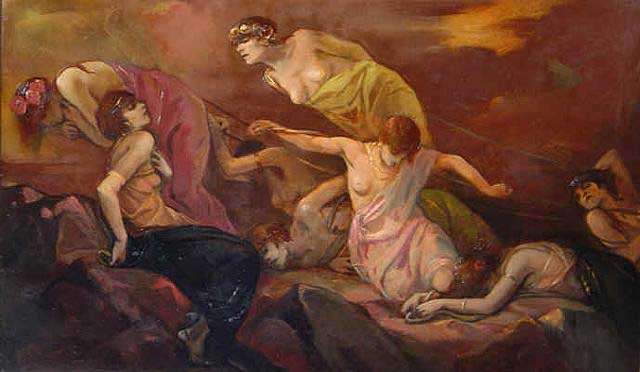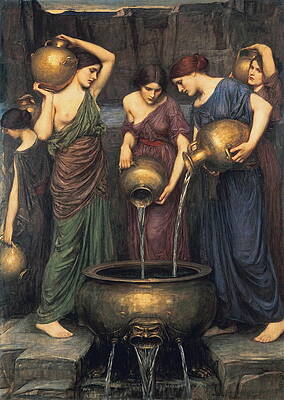.

Danaus, or Danaos (Δαναός) ("sleeper") was a Greek mythological character, twin brother of Aegyptus and son of Belus, a mythical king of Egypt. The myth of Danaus is a foundation legend (or re-foundation legend) of Argos, one of the foremost Mycenaean cities of the Peloponnesus. In Homer's Iliad, "Danaans" ("tribe of Danaus") and "Argives" commonly designate the Greek forces opposed to the Trojans.
Danaus had fifty daughters, the Danaides, and his twin brother, Aegyptus, had fifty sons. Aegyptus commanded that his sons marry the Danaides. Danaus elected to flee instead, and to that purpose he built a ship, the first ship that ever was. In it he fled to Argos, to which he was connected by his descent from Io, the maid wooed by Zeus and turned into a heifer and pursued by Hera until she found asylum in Egypt. So in a sense this was a homecoming for the sailor from Egypt. Argos at the time was ruled by King Pelasgus, the eponym of all autochthonous inhabitants who had lived in Greece since the beginning, also called there Gelanor (he who laughs). The Danaides ask Pelasgus for protection when they arive, the event portrayed in The Suppliants by Aeschylus. Protection is granted after a vote by the Argives.
When Pausanias visited Argos in the 2nd century AD, he related the succession of Danaus to the throne, judged by the Argives, who "from the earliest times... have loved freedom and self-government, and they limited to the utmost the authority of their kings:"
"On coming to Argos he claimed the kingdom against Gelanor, the son of Sthenelas. Many plausible arguments were brought forward by both parties, and those of Sthenelas were considered as fair as those of his opponent; so the people, who were sitting in judgment, put off, they say, the decision to the following day. At dawn a wolf fell upon a herd of oxen that was pasturing before the wall, and attacked and fought with the bull that was the leader of the herd. It occurred to the Argives that Gelanor was like the bull and Danaus like the wolf, for as the wolf will not live with men, so Danaus up to that time had not lived with them. It was because the wolf overcame the bull that Danaus won the kingdom. Accordingly, believing that Apollo had brought the wolf on the herd, he founded a sanctuary of Apollo Lycius."
—Pausanias, Description of Greece, 2.19.3 - .4
The sanctuary of Apollo Lykeios ("wolf-Apollo", but also Apollo of the twilight) was still the most prominent feature of Argos in Pausanias' time: in the sanctuary the tourist might see the throne of Danaus himself, an eternal flame, called the fire of Phoronius.
When Aegyptus and his fifty sons arrived to take the Danaides, Danaus gave them, to spare the Argives the pain of a battle. However, he instructed his daughters to kill their husbands on their wedding night. Forty-nine followed through, but one, Hypermnestra (or Amymone, the "blameless" Danaid) refused because her husband, Lynceus, honored her wish to remain a virgin. Danaus was angry with his disobedient daughter and threw her to the Argive courts. Aphrodite intervened and saved her. (Lynceus later killed Danaus as revenge for the death of his brothers). Lynceus and Hypermnestra then began a dynasty of Argive kings (the Danaan Dynasty).
In some versions of the legend, the Danaides were punished in Tartarus by being forced to carry water through a jug with holes, or a sieve, so the water always leaked out.
The remaining forty-nine Danaides had their grooms chosen by a common mythic competition: a foot-race was held and the order in which the potential Argive grooms finished decided their brides (compare the myth of Atalanta).
Even a cautious reading of the subtext as a vehicle for legendary history suggests that a Pelasgian kingship in archaic Argos was overcome, not without violence, by seafarers out of Egypt (compare the Sea Peoples), whose leaders then intermarried with the local dynasty. The descendants of Danaus' "blameless" daughter Hypermnestra, through Danae, led to Perseus, founder of Mycenae, thus suggesting that Argos had a claim to be the metropolis, or "mother city" of Mycenae.
It has been suggested that the figure Danaus represents an actual Egyptian monarch, possibly identified with the pharaoh Akhenaton (as accounted by the ancient Greco-Aegyptian, Manetho). Furthering the parallel, the character of Aegyptus bears similarities with the pharaoh Ay. This leads some to believe that the Aegyptiads were an Egyptian army that was sent by Ay and Ammonian priests to punish Akhenaton and Atenists, and, following from this presumption, that the Danaids were Egyptians who followed Akenaton to Greece after his escape from Egypt.
-------------------------------------------------------------------------------

The Lost Labour of the Danaides, G. A. Storey

Danaidae, Erzsebet Korb 1925

Les Danaides, Jan Frans De Boever, 1927
Another Danaus, possibly the same as the one above, had three daughters, Ialysa, Kamira and Linda, who were worshipped on Rhodes, where he stopped and founded a sanctuary to Athena on the way from Egypt to Greece.
Danaides, John William Waterhouse
See also : Greek Mythology. Paintings, Drawings
| Ancient Greece
Science, Technology , Medicine , Warfare, , Biographies , Life , Cities/Places/Maps , Arts , Literature , Philosophy ,Olympics, Mythology , History , Images Medieval Greece / Byzantine Empire Science, Technology, Arts, , Warfare , Literature, Biographies, Icons, History Modern Greece Cities, Islands, Regions, Fauna/Flora ,Biographies , History , Warfare, Science/Technology, Literature, Music , Arts , Film/Actors , Sport , Fashion --- |
Retrieved from "http://en.wikipedia.org"
All text is available under the terms of the GNU Free Documentation License


